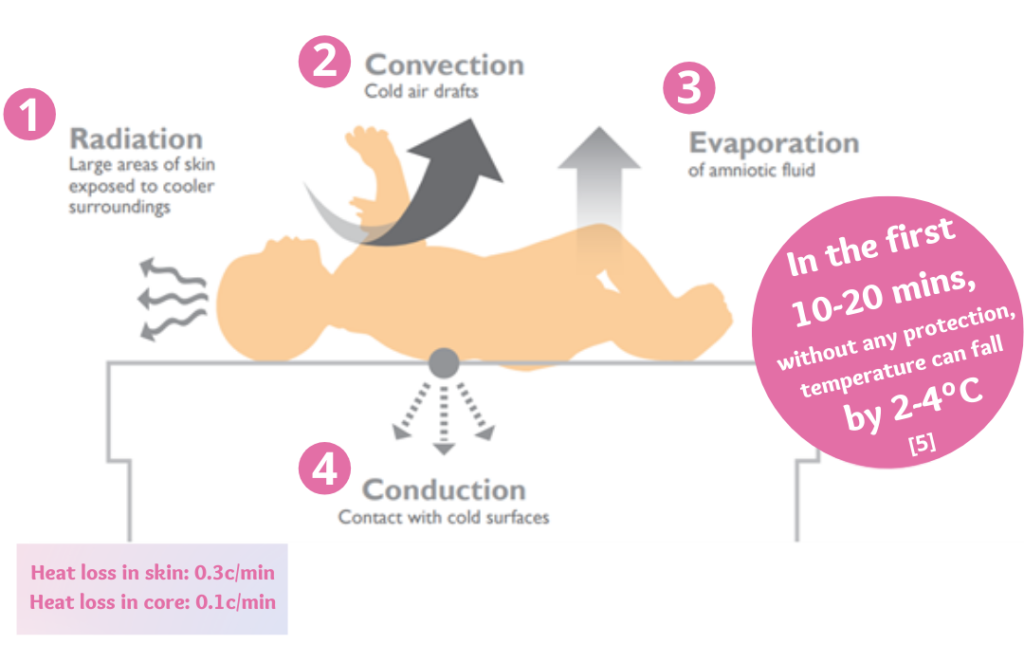Neonatal Hypothermia: The Silent Killer in Infants

WHO Classification of Hypothermia in Neonates
Neonatal Hypothermia is a medical condition where the axillary body temperature drops to a potentially dangerous level, below 36.5 ֯C (97.7 ֯F), anything below the normal neonate body temperature range of 36.5֯ C to 37.5 ֯C (97.7 ֯F – 99.5 ֯F), as defined by World Health Organisation. This continual inability to produce sufficient body heat may be attributed to a multitude of reasons involving prolonged exposure to cold temperatures, which is detrimental to the baby’s health, progressively increasing the chances of neonatal morbidity and mortality.
A study conducted on 500 neonates in Nepal, showed that 85% of them were hypothermic (body temperature < 36 ֯C) 2 hours after delivery.[1]
Previous studies revealed that with every 1 ֯C fall in neonate’s body temperature the risk of sepsis increases by 11% and chances of death increase by a startling 28%. [2]
Incidence of Hypothermia on admission to NICU from the delivery room was found to be :
- ≥ 56% for infants < 750g
- ≥ 25% for infants ≤ [3]
Factors of Neonatal Hypothermia:
Some of the main factors that drastically increase the chances of Neonatal Hypothermia are,
- Preterm babies
- Low birth weight
- Sepsis
- Poor transporting conditions
- Low environment temperatures (AC rooms, wet linen, etc.)
Causes of Neonatal Hypothermia:
Physical Characteristics of preterm infants and Environmental Factors
 The inherent physical characteristics of preterm infants that impairs the thermoregulatory mechanism are:
The inherent physical characteristics of preterm infants that impairs the thermoregulatory mechanism are:
- Large body surface area to weight ratio
- Incapacity to shiver to generate heat
- Inadequate stores of subcutaneous insulating fat
- Negligible capacity to generate heat (Brown adipose tissue)
- Underdeveloped epidermal barrier
- High respiratory rate, etc
The environmental factors that are responsible for the incidence of Neonatal Hypothermia are:

Symptoms of Neonatal Hypothermia:
- Rectal temperature < 95 ֯ F (35 ֯ C)
- Pale, cold skin (may turn blue in Acrocyanosis)
- Difficulty in breathing
- Weak/excessive cry
- Lethargic
- Poor feeding
Some of the complications of neonatal hypothermia include Respiratory Distress Syndrome, hypoxia, sepsis, cardiac arrest, and, in the worst case, even death.
Neonatal mortality is defined as the death of a neonate within 28 days from birth and we can unquestionably conclude that neonatal hypothermia is a crucial indicator of neonatal wellbeing, and survival rate.
Hence this necessitates the need for prevention and interventional measures to rewarm the neonate at the earliest, without neglecting the telltale signs.
Prevention Strategy:

One such highly effective method of preventing heat loss is using Vygon’s NeoHelp, a sterile double polyethylene layered suit to swaddle the baby, immediately after delivery (before resuscitation), implementable on both, term, and preterm babies. NeoHelp has exclusive features like an adjustable hood, complete transparency, a central Velcro opening, and a pre-shaped foam cushion in the back all designed to provide an occlusive effect. It is simple, easy-to-use, convenient, and eliminates all kinds of heat losses from the baby.
According to UNICEF, such interventions can reduce neonatal morbidity or mortality by a good 18-24%. [6]
Children are the world’s most valuable resource and its best hope for the future.
– John F.Kennedy
and with every baby lost we lose an indispensable part of our future.
References: –
[1] Johanson, R., Spencer, S., Rolfe, P., Jones, P. and Malla, D., “Effect of post-delivery care on neonatal body temperature.” Acta Paediatrica, 81: 859-863 (1992). https://doi.org/10.1111/j.1651-2227.1992.tb12123.x
[2] T.Cordaro, A.G. Phalen, K.Zukowsky, “Hypothermia and Occlusive Skin Wrap in the Low Birth Weight Premature Infant: An Evidentiary Review”, NAINR, Volume 12, Issue 2, (2012), Pages 78-85. https://doi.org/10.1053/j.nainr.2012.03.001
[3] Bhatt, D., White, R., Martin, G. et al. “Transitional hypothermia in preterm newborns.” J Perinatol 27, S45–S47 (2007). https://doi.org/10.1038/sj.jp.7211842
[4] Yibeltal Asmamaw Yitayew, Endashaw Belayhun Aitaye, Helina Wondimu Lechissa, Lubaba Oumer Gebeyehu, “Neonatal Hypothermia and Associated Factors among Newborns Admitted in the Neonatal Intensive Care Unit of Dessie Referral Hospital, Amhara Region, Northeast Ethiopia” International Journal of Pediatrics, vol. 2020, Article ID 3013427, 8 pages, (2020) https://doi.org/10.1155/2020/3013427
[5] World Health Organization. “Thermal protection of the newborn: a practical guide 1997.” Geneva, Switzerland: WHO (2017)
[6] Wariki, W. M. V., and R. Mori. “Interventions to prevent hypothermia at birth in preterm and/or low-birth-weight infants: RHL commentary.” The WHO Reproduction Health Library (2010).








